Pornography in the heart of Shanghai? I Don’t Think So!
If I were to ask you what the three largest events held on this planet were, you’d probably guess the Olympics; probably even the World Cup too.
But how about World Fairs?
An Expo (for, of course, that is its proper name) is a global multifaceted event where extraordinary exhibitions, diplomatic encounters, business meetings, public debates and live shows take place at the same time – according to expomuseum.com, that is. And according to that same web site, “a typical day at Expo would be: navigating over the Arctic Ocean thanks to digital technologies (Russian pavilion, Expo Yeosu 2012), seeing a robot play the flute (Expo Aichi 2005) and engaging in a debate on energy efficiency in cities (Expo Astana 2017) during the day, and listening to a concert of Santana (Hanover 2000) or seeing a performance of the Cirque du Soleil (Zaragoza 2008) in the evening.”
So why am I blathering away about Expos? And what’s this reference to pornography (which, be honest, is the main reason you have decided to read this blog, isn’t it?) Read on…
Well, a newly-opened museum in Shanghai now offers visitors a glimpse into the history of the World Expo movement. It’s located, not surprisingly, in a 9,000-square-metre space on the redeveloped site of the Shanghai Expo 2010, and it’s billed as the world’s only museum dedicated to the history and culture of World Expo fairs.
It even has its own subway station (on Line 13).
Inside, eight exhibition halls display around 3,000 objects relating to expo fairs through the ages. Just inside the first hall is a timeline showing the plethora of world fairs since the middle of the 19th century. I had never realised just how many there were…
The very first world expo was held in London in 1851. I never thought I’d come all the way to China to learn about the Crystal Palace – designed by Joseph Paxton – and a technological innovation in itself. It took me right back to my BBC days when I produced and presented a series of programmes in the 1980s on Victorian Builders, with the second programme concentrating on the life and works of Paxton.
Planned like a great greenhouse, the Crystal Palace was built from iron and glass pieces which had been produced in Birmingham. It was 564 metres long and 39 metres high, and had been designed to be set up and dismantled with ease, a bit like a massive Meccano set. It was later relocated to Sydenham, where it was renamed the New Crystal Palace. (Unfortunately it was destroyed by fire in 1936.)
And here in Hall 1 is a massive (1:100 scale) model of the structure. What a way to start an exhibition on World Expos!
Since 1851, there have been many events held throughout the world which have been called "World Fair", "International Exposition", "Universal Exposition", "World Expo", or simply "Expo".
By the 1920s there were so many of these events that the Bureau International des Expositions (BIE) was formed to try and bring some kind of order to it all and to help control the quality and frequency of the events. With the exception of the 1964-5 New York World Fair, all of these events since World War II have been held under the auspices of the BIE.
But back to the 19th century. Of all the world’s cities, Paris can lay claim to being one of the most influential in the history of the world expo movement. It was the only city to hold six events in less than a century: 1855, 1867, 1878, 1889, 1900, and 1937. The transformations these brought to Paris included the construction of new bridges, avenues, and buildings that changed the face of Paris for ever.
Prior to the Great War, machines were given premium locations at all world expos. Machines, and the engines that powered them, were displayed in huge galleries. The 1851 Great Exhibition in London had a Hall of Machines; the 1855 Paris Expo also had one that was 1000 metres long; the hall built at the 1915 San Francisco Expo was so big that a small airplane was able to perform a flight in its interior!
This is a model showing what the Paris Expo Machines Hall would have looked like…
… which you can compare to the actual vista below…
Over in Austria, just 18 years later, the Vienna Exposition commemorated the 25th anniversary of the coronation of Franz Joseph 1. It displayed the industrial might of the Austro-Hungarian Empire as a strategic gateway connecting East and West. Expo 1873 was responsible for the renovation of Vienna with a rerouting of the Danube and the reconstruction of the Ring – the oldest part of the city. The Palace of Industry was topped by its rotunda, which was then the largest dome in the world. It had 16 galleries on each side, and its engine hall and hall of arts were the highlights of the expo.
This particular gallery in the museum has a number of models of the 19th century expos, all sitting against the backdrop of a spectacular video wall.
The next gallery features inventions of the time that were shown off in the numerous expos that took place in the latter half of the 19th century. The telephone, for instance…
But the garish plastic models that accompany this part of the display lower the tone considerably, making it all appear like some super-kindergarten playroom. Sad.
Throughout the museum is a collection of posters used for the majority of the expos throughout the ages. Here, for instance, is one for the 1902 Auto Expo in France.
But what is this? A poster in Amharic? Ah… no… it appears that someone has printed the Panama Pacific Expo of San Francisco poster the wrong way around. Awww… sweet!
If the earlier Expos from 1851 to the middle of the 20th century were strongly influenced by the Industrial Revolution, the two World Wars completely changed the idea of technology as a source of progress. Now the emphasis was on the promotion of human progress and international dialogue, with technology being used for human development.
The Expo 1958 in Brussels, for instance, was dedicated to "Progress and Mankind"; Expo 1962 Seattle was about "Man in the Space Age"; and Expo 1967 Montreal was dedicated to "Man and his world."
I well remember the Brussels “Atomium”, because at the ripe old age of 8, I was heavily into collecting postage stamps and I got a first-day-cover featuring the Atomium on a set of Belgian stamps for my collection. The Atomium is still standing in Brussels (one of the few things in that city worth going to see, IMHO).
Apart from the host countries using their expos to show off their best to the world, the number of participating countries increased year after year: 39 in Brussels, 62 in Montreal, 78 in Osaka, 109 in Seville 1992, 155 in Hannover 2000, and 193 in Shanghai 2010.
Since the Beijing Olympics of 2008, China has become very good at showcasing itself to the world; and the Shanghai Expo was no exception in this regard.
“Expo 2010 Shanghai,” we are told, “set a milestone in the history of World Expo with the widest participation. It marked a gorgeous chapter in the more than 160 year history of World Expo with a successful splendid event.”
So by the time we get to Hall 5, we’re ready for a “Panorama concept [of the Shanghai Expo] from the overview, bidding success, preparation work planning, and from the successful bidding of World Expo in 2002 to the closing on October 31 2010. It showcases the transformation of Expo Park in an area of 5.28 sq km from space.”
The mascots of Shanghai Expo are, naturally, on display, though I don’t remember ever having seen them before. )Obviously they are not as eye catching as the Beijing Olympic mascots from two years earlier.)
But mascots aside, the success of these events can often be measured by the number of visitors. 19 million people visited Hanover 2000, 22 million went to Aichi 2005 and Expo Shanghai 2010 broke the record with 73 million tickets sold, the blurb tells us smugly.
In fact, the 73.08m visitors equated to around 400,000 visitors per day, with all records being broken on October 16 when 1,032,800 visitors walked through the turnstiles.
That year also saw 246 participants, 56 visitor service centres, 11,500 metres of benches, 110,000 stools, 1,854 drinking taps, 11,000 toilet cubicles, 42,000 cooling spray nozzles, 30,000 dining seats; 250,000 portions of food served every day… the list just goes on and on. This is a good news story that the burgers of Shanghai are milking for all it is worth.
Apart from reading about how wonderful the planning was, and how the Chinese authorities got everything to be just perfect for such an event, we are also treated to a number of artefacts from both Shanghai, and other expos that have ended up in this museum.
From the Finland Pavilion in Shanghai, for instance, is this rather attractive National Day Porcelain Bird… (participating countries and international organisations selected a day as their ‘pavilion day’ to hold various activities for displaying their culture. They also sent gifts with their national characteristics to the sponsors).
… while I am rather taken with this Red Official Ware Pipa Bottle ‘Yunbaixhi’ donated by the China Pavilion at Expo 2015 in Milan…
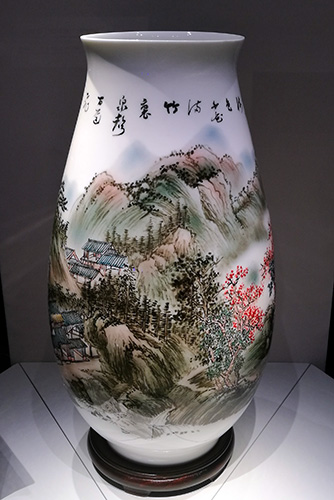
The Papua New Guinea Pavilion, meanwhile, reflected their culture with this ‘human shaped sculpture’ made of wood and iron sheets that “reflects the lifestyle of people in Pacific island countries”. Looks to me as if these two characters have consumed far too much kava! Definitely a case of morning-after-the-night-before syndrome!
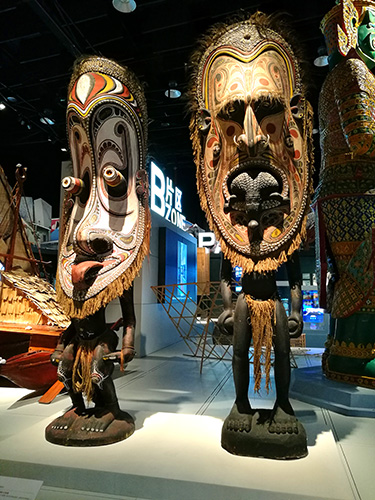
From Indonesia we are told that this "Percussion instrument comes from a Gamelan, which is the most representative music genre”. Actually the instrument is called an Angklung and its music has become the cultural identity of Sundanese communities in West Java and Banten.
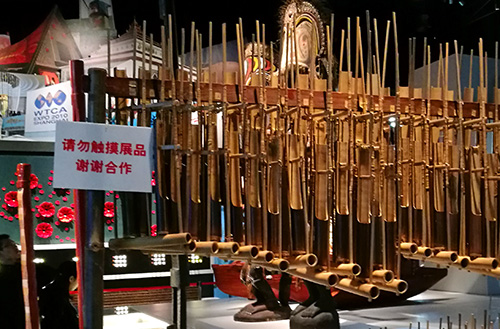
According to Wikipedia, In Bali, an ensemble of Angklung is called Gamelan Angklung. While the ensemble gets its name from the bamboo shakers, most modern compositions for Gamelan Angklung do not use them. An ensemble of mostly bronze metallophones is used instead, generally with about 20 musicians.
But no matter. Next to the collection of Angklung is a Door God of Thailand's Temple of Reclining Buddha which stood at the gate of the Thailand Pavilion in Shanghai.
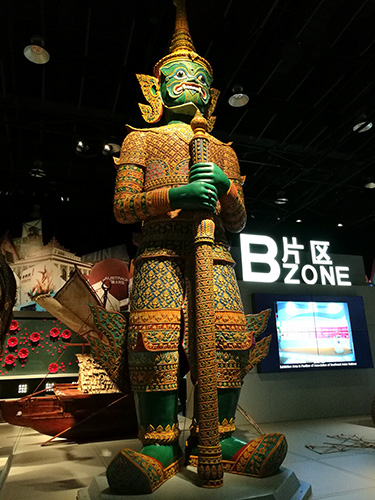
And now the bit you’ve all been searching for…
Here is what is described as Dabie Mountain Ruby Carving "Red Plum and Pornographic Fan"
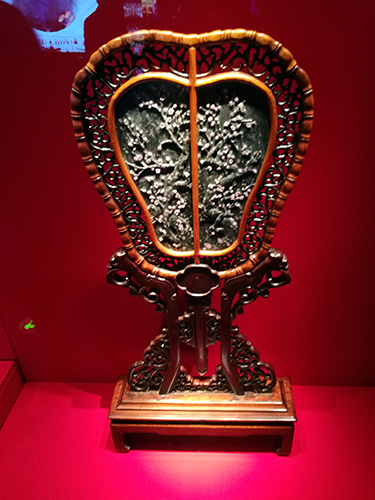
I look closely, searching for anything remotely looking like naughty motifs… Nothing!
I half close my eyes and squint at it, wondering if the shape of the fan has some kind of sexual connotation. Nope. (But maybe I am too pure and innocent to know about such things.)
I look at the accompanying notice once again… Yes, it is quite clear in its description.

Finally I get out my google-translate app to find out what the Chinese says…
“Red plum Spring Palace Fan” it reads.
Nothing to do with pornography here.
It is only later that a Chinese friend of mine explains to me that the term Spring Palace has a double meaning… it appears it is a euphemism for pornography. The Expo Museum curators have obviously used Baidu Translate and not double checked on the result!
(Just think if Beijing’s Summer Palace had instead been called Spring Palace… we might all now regard Empress Dowager Cixi in a different light!)
We head towards the exit. But not before going through yet another hall where Beethoven’s 9th Symphony is blasting out against an impressive multi-coloured light column, surrounded by a look towards the future…
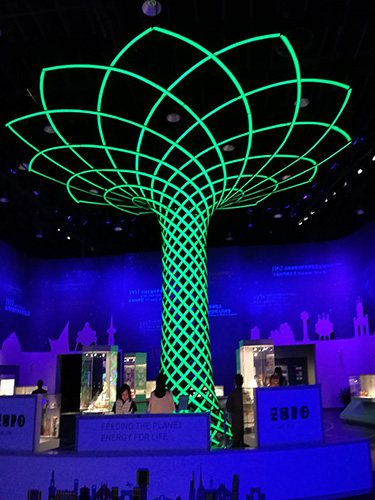
The next world's fair, Expo 2017 will be held in Astana, Kazakhstan, we are told. Hang on… isn’t that over now? Yes. It took place from June 10 to September 10, 2017. Ah well. Never mind.
Dubai will host Expo 2020, when it is expected to attract 25 million visitors in its 6-month run.
Three cities on three continents are bidding for the 2022-2023 slot: Buenos Aires, Argentina; Lodz, Poland; and Minneapolis, USA.
Four cities are bidding to host Expo 2025: Baku, Azerbaijan; Ekaterinburg, Russia; Osaka, Japan; and Paris, France.
And closer to home the 2019 Horticultural Expo will be held in Yanqing District in Beijing. It will be organised under the theme “Live Green, Live Better” (what marketing guy thinks up these silly titles?), and will be open between 29 April and 7 October 2019.
But if you are looking for pornography, I’d look elsewhere if I were you.
